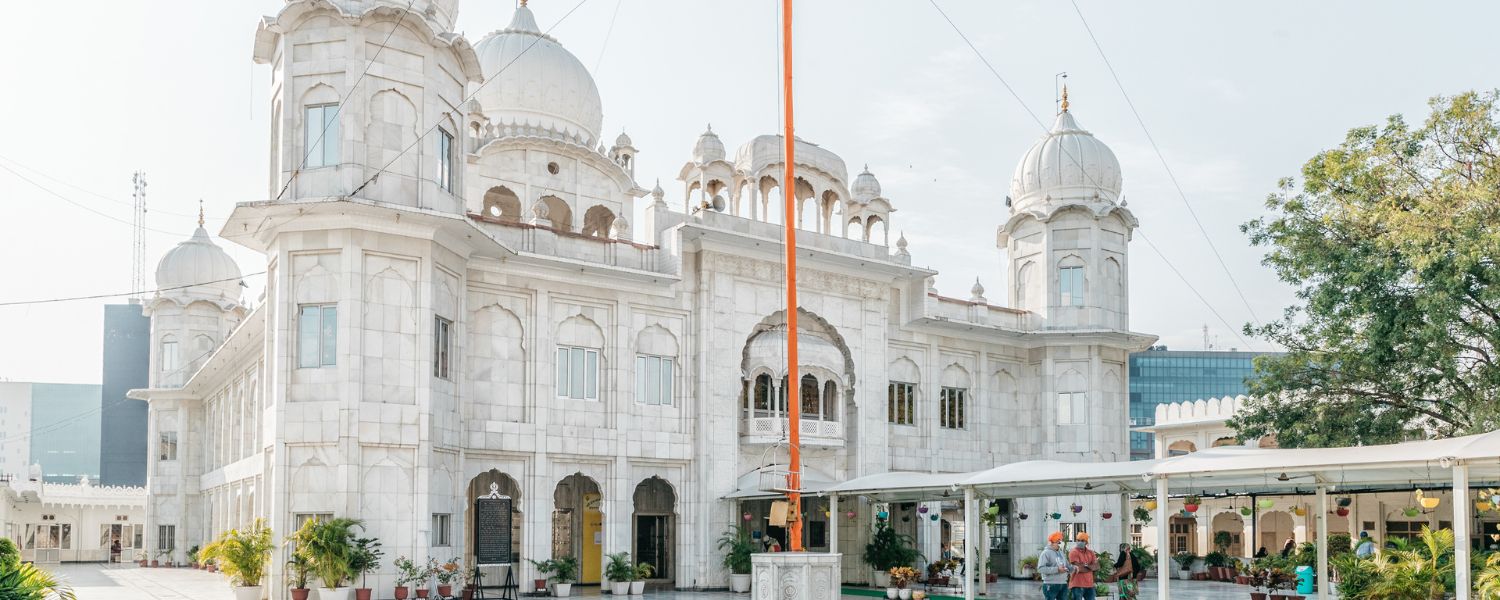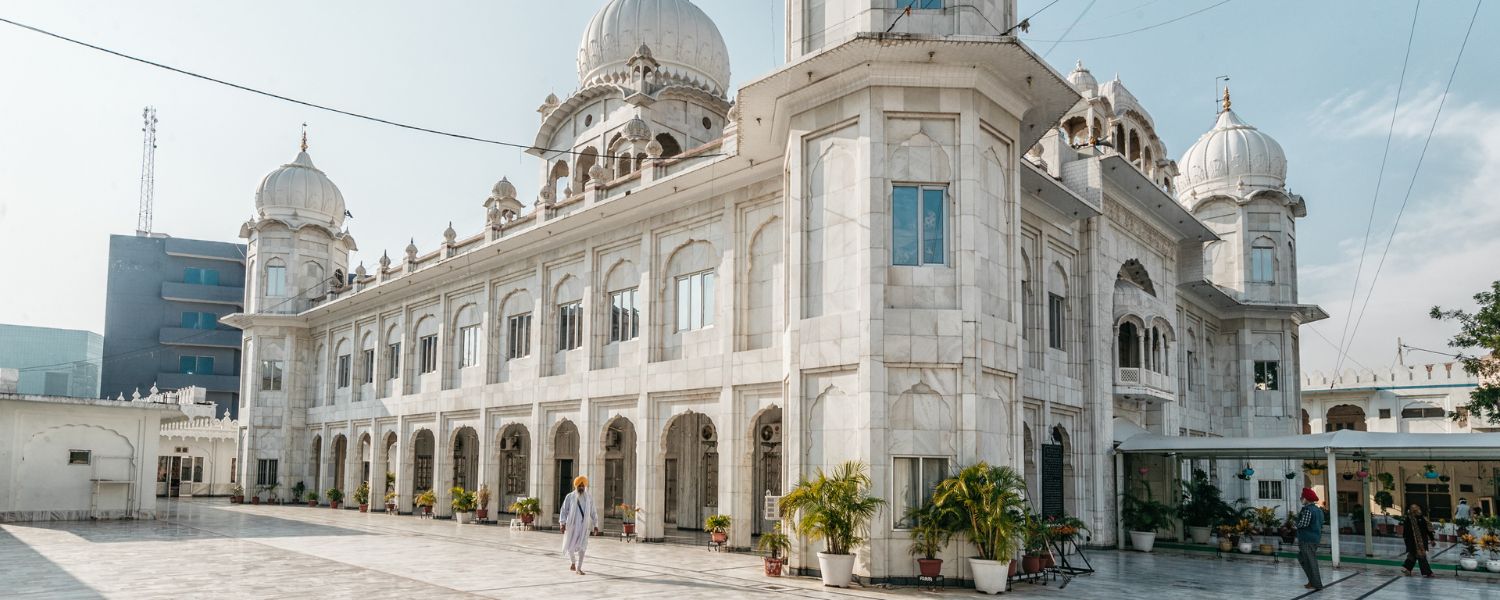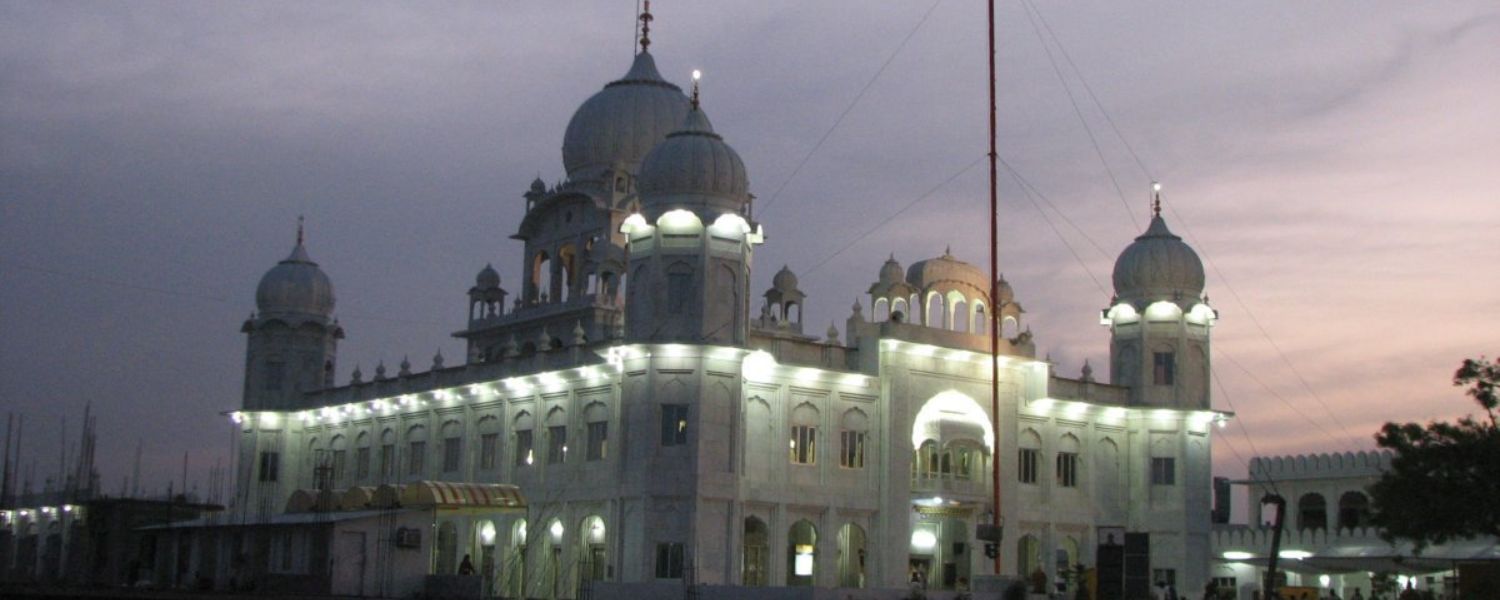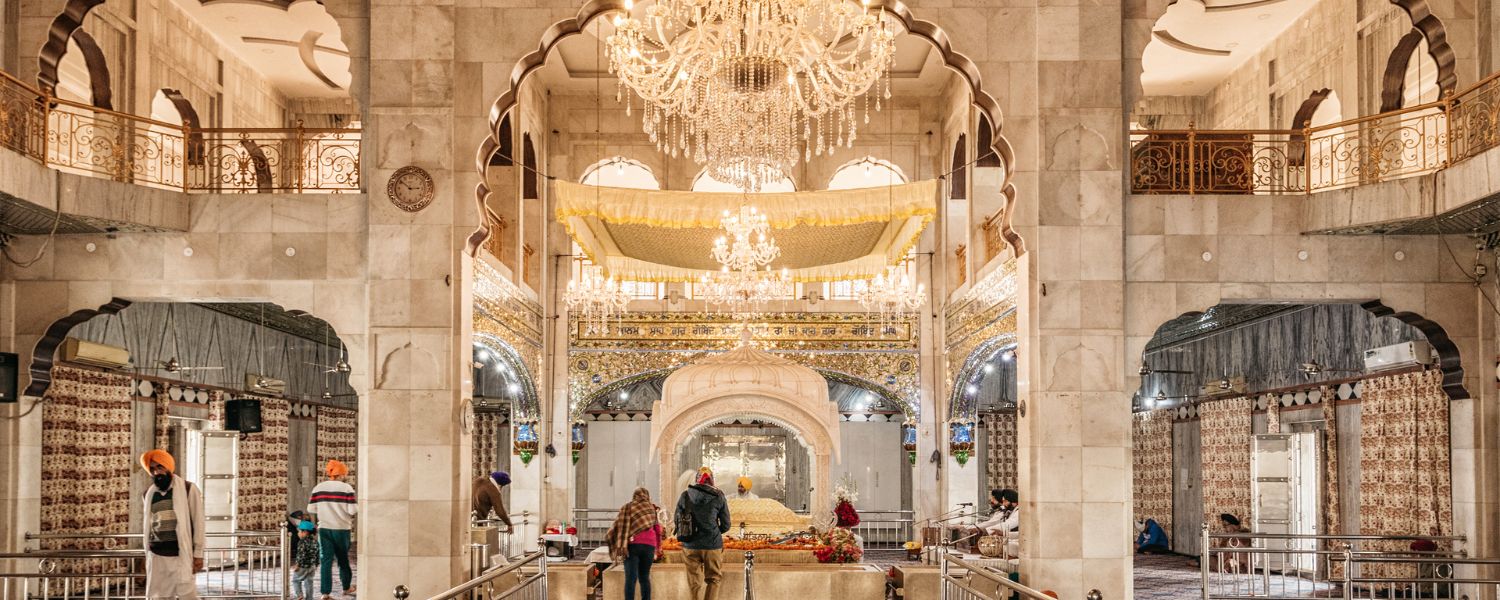Nada Sahib Gurudwara, nestled amidst the tranquil environs of the Panchkula district in Haryana, is a testament to faith and history.
This sacred site holds profound significance for the Sikh community, being the halting point of Guru Gobind Singh Ji during his journey from Paonta Sahib to Anandpur Sahib after the Battle of Bhangani in 1688.
Perched on the banks of the Ghaggar-Hakra River against the backdrop of the majestic Sivalik Hills, Sahib Gurudwara exudes an aura of serenity and spirituality.
The gleaming white two-storeyed dome-shaped structure serves as a beacon of solace for devotees seeking inner peace and solace.
Believers flock here, drawn by the promise of divine intervention and the fulfillment of heartfelt wishes. Legend has it that prayers offered at Gurudwara Sahib during five full-moon nights hold the power to manifest one’s desires into reality.
1. Gurudwara details

Nada Sahib Gurudwara, a serene sanctuary nestled in the lap of Panchkula, Haryana, stands as a beacon of spiritual solace for devotees far and wide.
Situated at Gurudwara 10th Paatshahi Sahib, this sacred site welcomes visitors daily from 4 A.M. to 9 P.M, extending its hours till 10 P.M. during full moon nights.
Its strategic Nada Sahib Gurudwara location, just 15 km away from Chandigarh, on the route to Morni Hills, offers pilgrims a tranquil retreat on the left banks of River Ghaggar.
With its doors open to all, regardless of creed or background, Nada Sahib Gurudwara embodies the essence of inclusivity and harmony.
Stepping into its hallowed grounds, visitors are greeted by the soothing ambiance and the resonance of hymns, invoking a sense of peace and reverence.
2. Nada Sahib Haryana- Significance

Nada Sahib, nestled in Haryana, holds profound significance in Sikh history. It marks the tranquil spot where the revered 10th Guru, Guru Gobind Singh Ji, paused following the Battle of Bhangani in 1688.
His journey from Paonta Sahib to Anandpur Sahib led him to this serene enclave. In our bustling lives, places like Sahib offer a sanctuary to slow down and immerse oneself in the essence of time. The ambiance of the Gurudwara exudes a divine energy, enveloping visitors in a sense of peace and spirituality.
It’s a place to contemplate, disconnect from the world’s chaos, and connect with one’s inner self. While my affinity lies with the Garden of Silence, Sahib holds its charm.
Here, amidst the tranquil surroundings, one can experience the beauty of spiritual serenity, an experience not bound to this place alone but undoubtedly felt in its embrace.
3. History

Nada Sahib holds a significant place in the history of Sikhism, serving as a pivotal stop during Guru Gobind Singh Ji’s journey from Paonta Sahib to Anandpur Sahib.
Following the Battle of Bhangani in 1688, where Guru Gobind Singh Ji and Bhim Chand of Bilaspur reached an accord, the Guru embarked on his journey, making several halts. Among these stops, Sahib stands out.
Situated between Paonta Sahib and Anandpur Sahib, the serene surroundings of Sahib provide a tranquil resting place for the Guru.
Along his journey, Guru Gobind Singh Ji’s presence and teachings left an indelible mark, fostering spiritual growth and unity among his followers.
A. Insight Into The Settlement
The Bachittar Natak, a significant text in Sikh history, recounts Guru Gobind Singh Ji’s victory in the battle, yet it doesn’t detail any territorial acquisitions to the nada sahib.
This absence of conquests has led historians like H. Raturi, Anil Chandra Banerjee, and A. S. Rawat to propose the likelihood of a settlement following the conflict.
They posit that materialistic ambitions didn’t drive Guruji’s intent; instead, his focus was on spiritual and moral principles.
It’s believed that saints like Guru Gobind Singh Ji prioritize peace and love over mere territorial gains. Thus, the absence of explicit mentions of territorial expansion aligns with Guruji’s higher ideals.
B. Story Behind the Gurudwara’s Name
Nada Sahib, a revered Gurudwara, derives its name from a heartwarming tale intertwined with Guru Gobind Singh Ji’s journey to Anandpur Sahib.
Amidst the wilderness, Guru Ji’s army halted, and a humble Lubana named Bhai Nadu Shah emerged as their gracious host.
Overwhelmed by his kindness, Guru Ji blessed the place with his name. He also prophesied that anyone with a pure heart visiting would have their wishes granted.
However, the significance of this spot remained obscure until Bhai Motha Singh stumbled upon it and erected a shrine to honor Guru Ji’s visit.
Today, a towering 105-foot holy flag, the Nishan Sahib, stands tall, marking the sanctity of the original Shrine. Sahib remains a beacon of hospitality and divine blessings, echoing the unity and generosity that characterized Guru Ji’s teachings.
C. Date of Establishment of the Manji Sahib at Nada Sahib
Nada Sahib holds a significant place in Sikh history, but the exact establishment date of the Manji Sahib remains in mystery. Little is known about Motha Singh or the initial founding of the Manji Sahib.
However, historic places in Haryana records indicate that by 1948, the Shrine fell under the administration of the Dharmath Board of PEPSU (Patiala & East Punjab States Union).
Following the merger of PEPSU with Nada Sahib history in Punjabi, the management transitioned to the Shiromani Gurudwara Parbandhak Committee in 1956.
While the precise origins may be uncertain, Sahib’s spiritual importance has endured through the ages, attracting devotees and pilgrims seeking solace and enlightenment.
5. Architecture

Nada Sahib, a serene sanctuary amidst nature’s embrace, boasts a captivating architectural marvel. The focal point is a double-storeyed domed structure housing a rectangular hall where devotees gather in spiritual communion, singing hymns (shabads) in unison.
A grand foyer welcomes visitors at the entrance, adorned with the majestic Nishan Sahib, a towering holy flag at 105 feet.
Here, one can relish the delectable servings of tea, accompanied by the irresistible kada parshad, a treat for the senses.
Additionally, the complex features a Guru Ka Langar Hall, where all are welcomed to partake in communal meals, embodying the spirit of equality and service.
Pilgrims find solace in the cozy nada sahib gurudwara room booking online tucked away in the back area, offering respite during their journey.
The outer area accommodates a community hall and a shoe house, ensuring convenience for visitors. Ample parking space further enhances accessibility, facilitating a seamless experience for all who seek solace at Nada Sahib.
5. Best Time To Visit

All Sundays and Purnamashi (full-moon nights) are prime choices! Picture this: the entire place is adorned with radiant lights, creating an enchanting atmosphere that adds a special touch to your visit. It’s like stepping into a realm of divine beauty and tranquility.
However, be prepared for longer queues during these peak times, especially during festivals; devotees flock in large numbers to pay their respects.
Plan, as you might have to wait an hour or two before reaching the sanctum sanctorum. Despite the wait, the experience is indeed worth it. The spiritual ambiance and festive fervor create an unforgettable journey of faith and devotion.
6. How To Reach

Gurudwara Nada Sahib, getting there is a breeze, thanks to its excellent connectivity with the Tricity – Panchkula, Chandigarh, and Mohali.
Whether you prefer the convenience of app-based rides like inDriver (Ola and Uber are less prevalent in this area), opt for government or local buses, or even choose autos, reaching Sahib is a hassle-free experience in the famous cities of Haryana.
For those arriving from different states, it’s a short journey of just 10 minutes (covering 5 kilometers) from the Panchkula Railway Station.
The Chandigarh Airport is approximately 40 minutes away if you’re flying in. Once you arrive, major local buses conveniently stop at the outer complex, right by the parking area of Sahib, ensuring easy access for all visitors.
7. Points To Keep In Mind While Visiting

When visiting Nada Sahib, remember several essential points to ensure a fulfilling experience. One of the best times to visit is during a full-moon night, or Poornima, when the atmosphere comes alive with stalls, sky lanterns, and a special langar.
Take advantage of the daily GuLangarLangar, where you can partake in the community meal. Remember to cover your head before entering the premises; it’s mandatory, and failing to do so might draw some unwelcome attention.
However, if you forget, there’s no need to worry, as free head coverings are available for borrowing. Once inside, remove your footwear as it’s not permitted within the Gurudwara premises.
You’ll receive a token in exchange, ensuring the safekeeping of your belongings. AccLangare rotis with both hands cupped as a sign of respect during langar. Volunteering for seva, or service, is open to anyone interested, without formalities.
After your visit, explore the small shops nearby offering souvenirs and items for offerings. Remember to recite the hukamnama of the day, typically written in Punjabi, displayed at the entry. Enjoy your visit to Sahib and immerse yourself in its spiritual ambiance.
8. Nada Sahib Gurudwara Room Booking

Nada Sahib Gurudwara, where warmth and hospitality greet every visitor. Situated amidst the serene surroundings, Sahib Gurudwara offers rooms to weary travelers and devotees seeking solace.
With rates ranging from INR 200 to 500 per night, accommodation here is affordable and comfortable, ensuring a peaceful stay for all.
However, it’s important to note that while the Gurudwara extends its hospitality to all nada sahib gurudwara room price, there is a modest requirement for female visitors.
Women traveling alone must be accompanied by a male member to avail of the accommodation facilities, as restrooms are not provided separately. At Gurudawra, the spirit of seva (selfless service) is alive and thriving, embodying the essence of Sikh teachings.
Conclusion
In conclusion, Nada Sahib is not only a physical sanctuary but also a timeless symbol of faith, hospitality, and spiritual rejuvenation.
Rooted deeply in Sikh history, this serene enclave draws devotees from far and wide, seeking solace and divine blessings.
The Gurudwara’s architectural magnificence and picturesque surroundings create an atmosphere of tranquility and reverence, inviting visitors to immerse themselves in prayer and contemplation.
The legendary tale behind its name, intertwined with Guru Gobind Singh Ji’s journey, adds an aura of mystique and inspiration to the site.
As devotees flock here to offer prayers and seek blessings, Sahib remains steadfast in its mission to preserve tradition, cultural practices, and the teachings of Sikhism.
With its rich history and spiritual significance, this sacred place continues to serve as a beacon of hope and enlightenment for generations to come, ensuring that the legacy of Sahib endures eternally.
FAQ
Q: Can we stay in Nada Sahib Gurudwara?
A: Yes, Nada Sahib Gurudwara offers accommodation facilities for visitors. Located 15 kilometers from the city center of Panchkula, it provides a serene environment for those seeking spiritual solace.
Alternatively, inexpensive dormitories near Chandigarh railway station are also available for accommodation.
Q: What is Panchkula famous for?
A: Panchkula is renowned for its meticulously planned infrastructure, featuring wide roads lined with lush trees and modern architectural marvels.
Moreover, it boasts the densest forest cover in Haryana, enhancing its natural allure and offering residents and visitors a serene environment.
Q: Which hat is the story of Anandpur Sahib?
A: Anandpur Sahib was established in June 1665 by the ninth Sikh Guru, Tegh Bahadur. Initially known as Chakk Nanaki after Guru Tegh Bahadur’s mother, it was founded amidst disputes with other sects of Sikhism, symbolizing a significant chapter in Sikh history.
Q: Who is the head of Granthi of Nada Sahib?
A: Bhai Jagjeet Singh has been the head of Granthi at Nada Sahib Gurudwara for 23 years. With 103 dedicated employees, the gurdwara ensures smooth operations and extends warm hospitality to all visitors.










